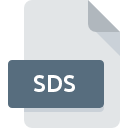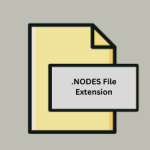.SDS File Extension

MIDI Sample Dump Standard File
| Developer | N/A |
| Popularity | |
| Category | Audio Files |
| Format | .SDS |
| Cross Platform | Update Soon |
What is an SDS file?
.SDS file extension primarily denotes a data file format known as Sample Dump Standard. It’s a format widely used for storing musical instrument samples, primarily in electronic and digital musical instruments like synthesizers and samplers.
The .SDS format is instrumental in the music production and sound engineering industries, as it allows the storage and transfer of sound samples across different systems and devices, ensuring compatibility and maintaining sound integrity.
More Information.
The Sample Dump Standard (.SDS) was introduced by the MIDI Manufacturers Association (MMA) and Japan MIDI Standards Committee (JMSC) as part of the MIDI (Musical Instrument Digital Interface) specification.
MIDI, established in the early 1980s, is a technical standard that describes a protocol, digital interface, and connectors and allows musical instruments, computers, and other related devices to connect and communicate with each other.
The .SDS file was a significant addition to this standard, focusing specifically on the accurate and efficient transfer of sample data.
The initial purpose of the .SDS file was to provide a universal format that could be used across different hardware and software platforms, ensuring that sound samples could be shared, edited, and utilized in various musical and sound engineering contexts without compatibility issues or quality loss.
Origin Of This File.
The .SDS file format emerged from the need for a standardized method to transfer sound samples between digital devices.
Before its introduction, transferring sound samples between devices from different manufacturers was often a complicated process due to the lack of a universal format, leading to compatibility issues and quality degradation.
The .SDS format was developed to address these challenges, providing a standardized, reliable method for storing and transferring digital sound samples.
File Structure Technical Specification.
.SDS file consists of a header and data chunks. The header contains essential information about the sample, such as sample rate, bit depth, and loop points.
Following the header, the file is divided into data chunks, each containing a portion of the sound sample’s digital audio data.
The file structure is designed to be both robust and flexible, ensuring that .SDS files can be used in a wide range of musical and technical scenarios.
The format supports mono and stereo samples, a variety of bit depths, and multiple sampling rates, making it versatile for different types of sound work.
How to Convert the File?
Converting .SDS files to other formats (and vice versa) typically require specialized audio software or conversion tools. Software like Audacity, Logic Pro, or Cubase often supports importing and exporting .SDS files.
For conversion, the process generally involves:
- Opening the .SDS file in the software.
- Making any necessary edits or adjustments to the sample.
- Exporting the file in the desired format.
While converting to other formats, some attributes of the sound sample may not be retained, depending on the target format’s specifications.
Advantages And Disadvantages.
Advantages:
- Compatibility: As a standardized format, .SDS files can be used across different platforms and devices, facilitating easy sharing and collaboration in music production and sound engineering.
- Quality Preservation: The format is designed to prevent quality loss during the transfer of sound samples, ensuring that the integrity of the audio is maintained.
- Flexibility: Supports various bit depths and sampling rates, catering to a wide range of audio fidelity requirements and uses.
Disadvantages:
- File Size: High-quality audio samples can result in large file sizes, leading to storage and transfer challenges.
- Complexity: The technical nature of the file structure may be challenging for users without specialized knowledge or tools, potentially hindering accessibility for casual users or hobbyists.
How to Open SDS?
Open In Windows
Music Production Software:
- Programs like Ableton Live, FL Studio, or Cubase are capable of opening and working with .SDS files.
- To open, launch the software, and use the ‘Open’ or ‘Import’ option to navigate to your .SDS file.
Dedicated Audio Editors:
- Tools like Audacity or Adobe Audition can also handle .SDS files.
- Open the program, and use the ‘File’ > ‘Open’ option to load your .SDS file.
Open In Linux
Audacity:
- Audacity is a cross-platform audio editor that can handle .SDS files.
- Install Audacity from your distribution’s package manager and use the ‘Open’ option to access the .SDS file.
Open In MAC
Logic Pro:
- Logic Pro is a professional music production software by Apple that supports .SDS files.
- Open the application, and use the ‘Import’ function to access your .SDS file.
Audacity:
- This free, open-source software can also be used on macOS to open and edit .SDS files.
- After installation, use the ‘Open’ function within Audacity to access the .SDS file.
Open In Android
Audio Editing Apps:
- While not as common, some audio editing apps on Android might support .SDS files. Apps like WaveEditor for Android™ Audio Recorder & Editor might be capable, but functionality will be limited compared to desktop software.
- Install the app from the Google Play Store and check if it supports importing .SDS files.
Open In IOS
GarageBand or Other Music Production Apps:
- iOS devices have limited support for .SDS files. Professional music production apps like GarageBand might offer some level of compatibility.
- Importing .SDS files into these apps may require additional steps, like using iTunes File Sharing or cloud storage services to transfer the files to your device first.













